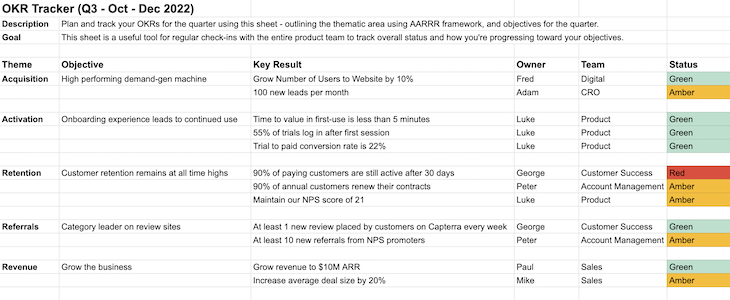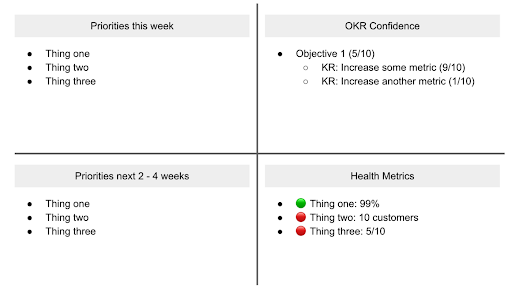Objectives and key results (OKRs) can assist product managers in guiding and focusing the team’s efforts, increasing impact, establishing alignment, and ensuring everyone is on the same page.

The OKR framework was developed by John Doerr while he worked at Intel in the early 1990s. Since then, OKRs have become a popular tool for measuring progress and enhancing performance in organizations as well as other settings.
Doerr’s book, Measure What Matters, demonstrates how to gather timely and relevant data to track progress so that you can improve your performance. In 2018, he also gave an excellent TED Talk on why the secret to success is about setting the right goals.
OKRs are widely used in product management because they allow product managers to concentrate on the objectives their business has set out to accomplish and rally others within the organization to focus on them too.
Using OKRs enables product managers to:
Although these are simply a few of the product manager’s many responsibilities, they are usually some of the most important. PMs often dig through data and create reports and dashboards to track progress toward key business goals and communicate updates to stakeholders.
PMs can create effective OKRs in collaboration with other functions and ahead of the next quarter.
There are three main alignment activities intended to triangulate effective product OKRs, which will help you avoid being caught off guard by new initiatives popping up during the quarter:
When establishing OKRs, it’s critical to match goals with the organization’s strategy and ensure that significant outcomes are measurable.
Checking in with leaders in other departments will help you ensure alignment and avoid missing initiatives you might be required to support from a product management perspective. It also enables you to identify any other urgent initiatives that might require development resources and the deprioritization of less urgent, strategic initiatives.
Some objectives may be linked to your overall product strategy. These goals might be confined to the product experience itself and contribute significantly to the company’s financial goals.
You should also collaborate with your engineering counterparts to identify capacity needs for executing the objectives across the company by aligning your product goals across the business.
There are a few things that product managers should keep in mind when setting up their OKRs:
To demonstrate how to create OKRs, let’s look at a couple of illustrative examples:
Create a high-performing demand-gen machine.
If you’re not objective-driven, there’s a good chance you’re just taking orders from the top. Either that or you’re a feature factory, or perhaps you’re executing on projects instead of optimizing toward objectives.
If you don’t have any formal goal-setting framework in place, try the following as a starting point:
Deliver X project by the end of the year.
If it’s too difficult to find measurable metrics for what you’re working on, perhaps it’s just a delivery-focused objective and the key success measure is to get something done by a given date, which is okay if that’s the milestone you’re working toward. You should still think about metrics you can pursue along the way that indicate whether or not you’re making the right type of progress.
Make sure you can actually obtain data on key results when you’re determining the crucial indicators that demonstrate your goal’s success. If there are any important success metrics you aren’t presently tracking, make sure they’re included in the scope and build them before you need to start referring to them.
A common mistake is to treat key results as a to-do list. Key results should be easily measurable; if you’re outlining tasks to be done, these should be considered as tactics — i.e., things we can do to hit the key result. This is best left to the team to weigh up the effort and prioritize the best possible tactics.
Tactics can be gathered by soliciting ideas from the broader team on how to hit the objectives. A workshop-style session led by the product manager would work perfectly here.
Ideally, you want no more than three to five objectives at each level of the organization as they cascade down. Individuals have their own goals, which should align with the functional and business objectives. Likewise, individuals should actively pursue no more than three to five objectives at any given time.
Limiting the number of objectives across the board and making sure everyone is aligned is important for capacity purposes, too.
Considering the example above, product, UX, and engineering might need to work together to ensure enough planning has been done to guarantee sprint velocity. Product and UX will need to work together to recruit customers and plan, run, and synthesize results from the interviews. This might limit their effectiveness in helping to define work for the engineering teams.
There are a few strategies for planning OKRs. When starting out, I recommend reviewing your pirate metrics (AARRR):
Here is a downloadable and customizable OKR template you can use when planning your OKRs. We also have templates available for the following (more on these later):

Reviewing and signing off OKRs with other functions is crucial to ensure you have alignment from the beginning and eliminate any surprises from occurring throughout the quarter.
As a product manager, you often have the context around what the business is trying to achieve and should meet with other functions to align OKRs and make sure everyone is aiming toward the same goal. It’s also an opportunity for you to understand what’s important to stakeholders and share what you’re hoping to achieve during the quarter.
Furthermore, it enables you to explore tactics together and determine what activities lend themselves to achieving the objectives as efficiently as possible.
In the OKR template linked above, the OKR Alignment tab provides a structure and checklist of the functions you should meet with to review and discuss OKRs for the quarter. Keep track of when the meetings are scheduled and any comments that need to be addressed as a result of the discussion.
By now, you’ve planned your OKRs for the quarter and are now into execution mode and working on what’s required to achieve your objectives.
There are a few key strategies to ensure you’re making the desired levels of progress, namely:
Open up your OKR plan with the team on a weekly basis and do a quick check on how you’re tracking toward the key results.
If everyone updates their status, a quick review might take no longer than five minutes, giving you time back to discuss issues on any objectives that are not on track.
Christina Wodtke offers a good template on how to track OKRs weekly in her book Radical Focus:

In your product management tool (e.g., Aha, ProductBoard, ProductPlan, etc.), items on your roadmap should be aligned to the objectives. It’s worth checking in on the progress of those items to ensure timelines are up to date. Again, you should discuss where there are impacts and issues with date slippage.
There is a plethora of strategies out there to make communication easier, yet we still default to meeting hell.
If you don’t have time to share progress in a team meeting, invest the time to make information self-service by producing reports. Sending a quick email, Slack update, Loom video, or Enform update will work to keep stakeholders up to date.
The format of the updates don’t need to be super onerous. Each section of your update should lead with the objective and key results. It should cover what you did last week in terms of accomplishments and what you’re working on next week.
Feel free to download and customize this OKR weekly update template to help you compose your own progress reports.
A quarterly review session is a perfect way to bookend the quarter, look ahead, and reset for the quarter ahead.
The quarterly review is important because:
As product manager, the quarterly review allows you to pause and reflect on all the great work everyone has done with regard to chasing particular objectives. This is an excellent artifact that can be shared directly with the engineering team and with stakeholders across the business.
The format of the quarterly review is straightforward and can be run as a 30–60 minute meeting:
To see what this looks like in practice, check out this real-world example of a quarterly review deck.
OKRs are a powerful tool product managers can use to drive focus and reach their product goals. Setting up effective OKRs and tracking progress enables product managers to keep their teams on track and focused on the right things.
Featured image source: IconScout

LogRocket identifies friction points in the user experience so you can make informed decisions about product and design changes that must happen to hit your goals.
With LogRocket, you can understand the scope of the issues affecting your product and prioritize the changes that need to be made. LogRocket simplifies workflows by allowing Engineering, Product, UX, and Design teams to work from the same data as you, eliminating any confusion about what needs to be done.
Get your teams on the same page — try LogRocket today.

Most teams fail at autonomy. Learn how clear rules help product teams move faster without micromanagement.

A practical framework for PMs to use AI in ideation without sacrificing judgment, strategy, or decision quality.

A practical five minute revenue estimation method to help product managers compare ideas, drop low impact features, and prioritize smarter.

A practical guide for PMs who want to stop being bottlenecks, delegate smarter, and lead teams effectively with a clear ownership framework.